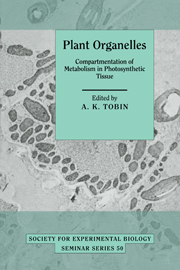Book contents
- Frontmatter
- Contents
- List of Contributors
- Preface
- Acknowledgements
- Metabolic interactions between organelles in photosynthetic tissue: a mitochondrial overview
- Metabolite transport in plant cells
- Metabolic interactions during photosynthetic and respiratory nitrogen assimilation in a green alga
- Carbon and nitrogen cycling between organdies during photorespiration
- Metabolic interactions between organelles in C4 plants
- Metabolic interactions in leaves of C3–C4 intermediate plants
- Metabolite compartmentation and transport in CAM plants
- Transport of H+, K+ and Ca2+ at the vacuolar membrane of plants
- Regulation of mitochondrial respiratory activity in photosynthetic systems
- Biosynthesis and assembly of the enzymes involved in lipid metabolism in plants
- The role of carnitine in plant cell metabolism
- Metabolic interactions of organelles in guard cells
- Transport of proteins into chloroplasts
- Metabolic interactions of organelles during leaf development
- Index
Transport of H+, K+ and Ca2+ at the vacuolar membrane of plants
Published online by Cambridge University Press: 05 December 2011
- Frontmatter
- Contents
- List of Contributors
- Preface
- Acknowledgements
- Metabolic interactions between organelles in photosynthetic tissue: a mitochondrial overview
- Metabolite transport in plant cells
- Metabolic interactions during photosynthetic and respiratory nitrogen assimilation in a green alga
- Carbon and nitrogen cycling between organdies during photorespiration
- Metabolic interactions between organelles in C4 plants
- Metabolic interactions in leaves of C3–C4 intermediate plants
- Metabolite compartmentation and transport in CAM plants
- Transport of H+, K+ and Ca2+ at the vacuolar membrane of plants
- Regulation of mitochondrial respiratory activity in photosynthetic systems
- Biosynthesis and assembly of the enzymes involved in lipid metabolism in plants
- The role of carnitine in plant cell metabolism
- Metabolic interactions of organelles in guard cells
- Transport of proteins into chloroplasts
- Metabolic interactions of organelles during leaf development
- Index
Summary
The vacuole is, in terms of volume, the dominant organelle of the vast majority of mature plant cells. Many of its functions have long been recognised (Dainty, 1968; Boiler & Wiemken, 1986; Matile, 1987; Raven, 1987). Thus, the vacuole provides a storage compartment for nutrients and metabolites, exhibits lysosomal characteristics as a major lytic compartment, and (by virtue of its size and relative metabolic inertness) enables the cell to achieve a large volume without compromising the high cytoplasmic surface-to-volume ratio that is necessary for efficient gas and nutrient exchange with the environment.
Increasingly, however, additional functions for the vacuole are being discovered. The presence of ion translocating phosphohydrolases at the vacuolar membrane (the tohoplast) implies that the vacuole plays an important role in cellular energetics (Rea & Sanders, 1987). Indeed the H+-pumping pyrophosphatase at this membrane appears (in photosynthetic tissue at least) to constitute the only means of hydrolysis of cytosolic pyrophosphate (PPi), which suggests that the organelle must be primarily responsible for the removal of PPi produced during biosynthetic reactions (Weiner et al, 1987). Furthermore, in accord with its role as a storage organelle, the vacuole seems likely to constitute a major source of second messengers which can be released into the cytoplasm during signal transduction (Boudet & Ranjeva, 1989).
- Type
- Chapter
- Information
- Plant OrganellesCompartmentation of Metabolism in Photosynthetic Tissue, pp. 169 - 188Publisher: Cambridge University PressPrint publication year: 1992
- 1
- Cited by



